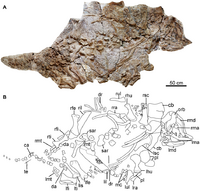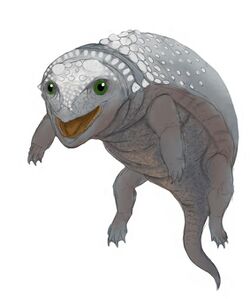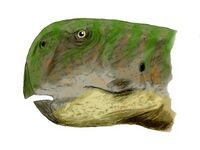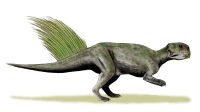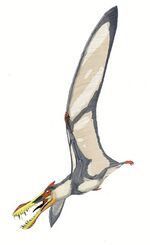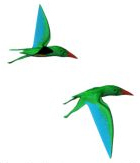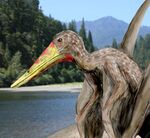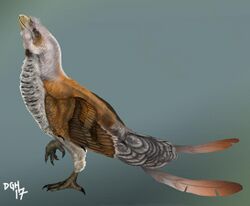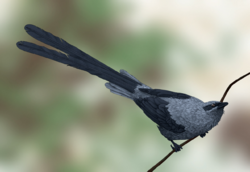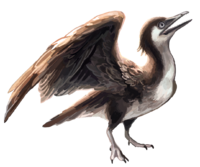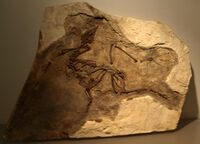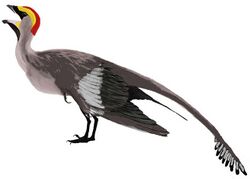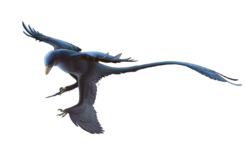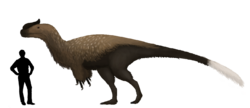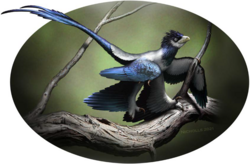Earth:Jiufotang Formation
| Jiufotang Formation Stratigraphic range: Aptian ~122–118.9 Ma | |
|---|---|
| Type | Geological formation |
| Unit of | Jehol Group |
| Sub-units | Shangheshou & Meileyingzi Beds |
| Underlies | Fuxin & Shahai Formations |
| Overlies | Yixian Formation |
| Lithology | |
| Primary | Mudstone |
| Other | Sandstone |
| Location | |
| Coordinates | [ ⚑ ] : 41°12′N 119°24′E / 41.2°N 119.4°E |
| Paleocoordinates | [ ⚑ ] 44°24′N 119°30′E / 44.4°N 119.5°E |
| Region | Liaoning |
| Country | |
| Type section | |
| Named for | Jiufotang, Pingfangzi, Liaoning |
| Named by | Ryuji Endo |
| Year defined | 1934[1] |
| Lua error in Module:Location_map/multi at line 27: Unable to find the specified location map definition: "Module:Location map/data/Liaoning" does not exist. | |
The Jiufotang Formation (Chinese: 九佛堂组; pinyin: jiǔfótáng zǔ) is an Early Cretaceous geological formation in Chaoyang, Liaoning which has yielded fossils of feathered dinosaurs, primitive birds, pterosaurs, and other organisms (see Jehol Biota). It is a member of the Jehol group. The exact age of the Jiufotang has been debated for years, with estimates ranging from the Late Jurassic to the Early Cretaceous. New uranium-lead dates reveal the formation is deposited in the Aptian stage of the Early Cretaceous.[2] Fossils of Microraptor and Jeholornis are from the Jiufotang.[3]
Fossil content
Choristoderans
| Genus | Species | County | Member | Abundance | Notes |
|---|---|---|---|---|---|
| Philydrosaurus | P. proseilus | Monjurosuchid | |||
| Ikechosaurus | I. pijiagouensis | Simoedosaurid | |||
| Liaoxisaurus | L. chaoyangensis | Simoedosaurid |
Fish
| Genus | Species | County | Member | Notes | Images |
|---|---|---|---|---|---|
| Caeruleum[4] | C. miraculum | Weichang | A lamprey | ||
| Jinanichthys | J. longicephalus | An osteoglossomorph | |||
| Lycoptera | L. davidi | An osteoglossomorph | |||
| Peipiaosteus | P. pani | A fish related to sturgeons | |||
| Protopsephurus | P. liui | A paddlefish | |||
| Sinamia | S. zdanskyi | An amiiform |
Mammaliamorphs
Several mammaliamorph specimens have been found from the Jiufotang, but only a few have been formally described and named.
| Genus | Species | County | Member | Material | Notes |
|---|---|---|---|---|---|
| Cokotherium | C. jiufotangensis[5] | Partial skeleton | A eutherian | ||
| Fossiomanus | F. sinensis[6] | A nearly complete skeleton | A tritylodontid cynodont, likely the youngest known non-mammalian synapsid | ||
| Liaoconodon | L. hui[7] | A nearly complete skeleton | A eutriconodont | ||
| Unnamed mammal | Unnamed | Partial remains including a foot and fragments of the skull | A mammal similar to Eomaia and Sinodelphys from the Yixian Formation. Found as stomach contents of Microraptor zhaoianus. |
Ornithischians
| Genus | Species | County | Member | Material | Notes | Images |
|---|---|---|---|---|---|---|
|
C. chaoyangensis[8] |
Liaoning | A nearly complete skeleton missing only the distal portion of the caudal series. |
A basal ankylosaurid, sister taxon to Liaoningosaurus.[8] |
|||
| Liaoningosaurus[9] | L. paradoxus[9] | |||||
|
Psittacosaurus meileyingensis |
Meileyingzi Bed |
"[Four] individuals, [two] complete skulls."[10] |
A ceratopsian. |
|||
|
Psittacosaurus mongoliensis |
Shangheshou and Meileyingzi Beds |
Pterosaurs
| Genus | Species | County | Member | Material | Notes | Images |
|---|---|---|---|---|---|---|
|
Chaoyangopterus |
C. zhangi |
A chaoyangopterid[11] | center|thumb|150px|Sinopterus and Huaxiadraco | |||
|
Eoazhdarcho |
E. liaoxiensis |
A chaoyangopterid[11] | ||||
|
Feilongus |
F. youngi |
Jianshangou Bed |
A boreopterid | |||
| Forfexopterus | F. jeholensis | A ctenochasmatid | ||||
|
Gladocephaloideus |
G. jingangshanensis |
Jingangshan Bed |
A ctenochasmatid | |||
| Guidraco |
G. venator |
A pteranodontoid[12] | ||||
| Hongshanopterus | H. lacustris | An istiodactylid | ||||
| Huaxiadraco | H. corollatus | Multiple specimens | A tapejarid[13] | |||
|
"H." benxiensis |
A tapejarid; synonymized with Huaxiadraco in 2023 | |||||
| Ikrandraco |
I. avatar |
A pteranodontoid[12] | ||||
|
Jidapterus |
J. edentus |
A chaoyangopterid[11] | ||||
|
L. gui |
A pteranodontoid[12] | |||||
|
L. brachyognathus |
An istiodactylid[11] | |||||
|
L. jennyae |
||||||
| Meilifeilong | M. youhao | Jianchang | A nearly complete skeleton and a partial skull | A chaoyangopterid[14] | ||
|
N. crypticus |
A tapejaromorph; previously and still occasionally thought to be a tapejarid. Most likely a juvenile, hence small size. | |||||
|
N. ignaciobritoi |
An istiodactylid[11] | |||||
| Pangupterus | P. liui | A pterodactyloid | ||||
|
Shenzhoupterus |
S. chaoyangensis |
A chaoyangopterid | ||||
| S. sanyainus | A chaoyangopterid[15] | |||||
|
S. dongi |
A tapejarid[11] | |||||
|
S. jii |
Previously known as Huxiapterus jii | |||||
|
Vesperopterylus |
V. lamadongensis |
An anurognathid |
Saurischians
A large titanosaur is present in the formation.[16]
Enantiornithines
| Genus | Species | County | Member | Material | Notes | Images |
|---|---|---|---|---|---|---|
|
Alethoalaornis |
Alethoalaornis agitornis[17] |
An enantiornithean |
||||
|
Boluochia zhengi |
"Partial skull [and] partial postcranium."[18] |
A longipterygid | ||||
| Brevirostruavis | Brevirostruavis macrohyoideus | "an extremely elongate bony hyoid element (only slightly shorter than the skull), combined with a short cranial rostrum."[19] | An enantiornithine | |||
|
Cathayornis aberransis |
An enantiornithine | |||||
|
Cathayornis caudatus |
Nomen dubium[20] | |||||
|
Cathayornis yandica |
"Partial skeleton."[18] |
An enantiornithean | ||||
|
Cuspirostrisornis houi |
A possible avisaurid | |||||
|
Dapingfangornis sentisorhinus |
An enantiornithean | |||||
|
Eocathayornis walkeri |
"Partial skeleton."[18] |
An enantiornithean | ||||
|
Gracilornis jiufotangensis |
An enantiornithean | |||||
|
Huoshanornis huji |
An enantiornithean | |||||
|
Largirostrornis sexdentoris |
An enantiornithean | |||||
|
Longchengornis sanyanensis |
An enantiornithean | |||||
|
Longipteryx chaoyangensis |
A longipterygid | |||||
| Musivavis | Musivavis amabilis | "A nearly complete and articulated skeleton preserved in a single slab."[21] | An euenantiornithean | |||
|
Rapaxavis pani |
A longipterygid | |||||
|
Shangyang |
Shangyang graciles |
An enantiornithean | ||||
|
Sinornis santensis |
"Partial skull [and] many nearly complete postcranial skeletons."[22] |
An enantiornithean | ||||
|
Xiangornis shenmi |
An enantiornithean | |||||
|
Yuanchuavis |
Yuanchuavis kompsosoura |
An pengornithid |
Euornithines
| Genus | Species | County | Member | Material | Notes | Images |
|---|---|---|---|---|---|---|
|
Aberratiodontus |
A. wui |
Junior synonym of Yanornis martini[23] |
||||
|
C. beishanensis |
"Partial skeleton."[22] |
A basal euornithean | ||||
|
J. microdonta |
Jianchang |
A basal euornithean | ||||
|
M. dentatus |
A schizoourid | |||||
|
P. chaoyangensis |
A hongshanornithid | |||||
|
P. lii |
An ornithuromorph | |||||
|
S. lii |
Jianchang |
A schizoourid with long, forked tail feathers | ||||
|
S. brevipectus |
An ornithuromorph | |||||
|
S. linghensis |
An ornithuromorph | |||||
|
Y. martini |
An ornithuromorph | |||||
|
Y. grabaui |
An ornithuromorph | |||||
|
Z. yangi |
A basal euornithean[25] |
Non-ornithothoracean theropods
| Genus | Species | County | Member | Material | Notes | Images |
|---|---|---|---|---|---|---|
| Chongmingia[26] | C. zhengi | A partial skeleton with preserved soft tissues | A jinguofortisid avialan | |||
|
C. sanctus |
A primitive short-tailed avialan (pygostylian). Also present in the Yixian Formation | |||||
|
C. jianchangensis |
Liaoning |
|||||
| Cratonavis[27] | C. zhui | Jianchang | A complete skeleton with preserved feathers | A jinguofortisid avialam | ||
|
D. cuhe |
Nomen dubium, named from a forged artificially assembled specimen. | |||||
|
J. prima[3] |
A jeholornithiform avialan, also present in the Yixian Formation[28] | |||||
|
J. palmapenis[29] |
A jeholornithiform avialan | |||||
|
K. longicaudatus |
"Nearly complete specimen".[30] |
A jeholornithiform avialan | ||||
|
M. gui |
Shangheshou Bed |
Extremely common[16] |
Could be synonym of Microraptor zhaoianus | |||
|
M. zhaoianus |
Shangheshou Bed[16] |
"At least [three] partial semiarticulated postcrania and several skulls."[31] Feathered integument is also preserved.[31] |
A dromaeosaurid. | |||
|
N. rectusmim |
A jeholornithiform avialan | |||||
|
O. sinousaorum |
An omnivoropterygiform avialan | |||||
|
S. angustis |
"Nearly complete skeleton without skull."[32] |
An omnivoropterygiform, a primitive short-tailed avialan | ||||
|
S. chaoyangensis |
||||||
|
Shenshiornis |
Shenshiornis primita[33] |
An omnivoropterygiform avialan | ||||
|
S. yixianensis |
An oviraptorosaur | |||||
|
S. kazuoensis[34] |
||||||
| Wulong[35] | W. bohaiensis[35] | Chaoyang, Liaoning[35] | Complete articulated skeleton (D2933).[35] | A dromaeosaurid |
Crustaceans
| Genus | Species | County | Member | Material | Notes | Images |
|---|---|---|---|---|---|---|
| Eosestheria | Eosestheria middendorfii[36] | A clam shrimp |
Plants
| Genus | Species | County | Member | Material | Notes | Images |
|---|---|---|---|---|---|---|
| Czekanowskia | Czekanowskia rigida[37] | A member of Czekanowskiales, Dominant | ||||
| Ginkgo | Ginkgo digitata[37] | A member of Ginkgoales | ||||
| Elatocladus | Elatocladus pinnatus[37] | Conifer foliage | ||||
| Pityolepis | Pityolepis ovatus[37] | Conifer cone | ||||
| Leptostrobus | Leptostrobus sinensis[37] | A member of Czekanowksiales, occasionally misspelled "Leptosthrobus" | ||||
| Baiera | Baiera valida[37] | A member of Ginkgoales | ||||
| Baiera cf. gracilis[37] | ||||||
| Ginkgoites | Ginkgoites trancata[37] | A member of Ginkgoales, dominant | ||||
| Gingkgoites trancatus[37] | ||||||
| Podozamites | Podozamites sp.[36] | Conifer foliage | ||||
| Sphenopteris | Sphenopteris sp.[36] | Seed plant foliage |
See also
- Yixian Formation
- List of dinosaur-bearing rock formations
References
- ↑ Endo, R. (1934) (in ja). Geology and mineral resources of Manchuria. Tokyo: Sanseido.
- ↑ Yu, Zhiqiang; Wang, Min; Li, Youjuan; Deng, Chenglong; He, Huaiyu (2021-12-01). "New geochronological constraints for the Lower Cretaceous Jiufotang Formation in Jianchang Basin, NE China, and their implications for the late Jehol Biota" (in en). Palaeogeography, Palaeoclimatology, Palaeoecology 583: 110657. doi:10.1016/j.palaeo.2021.110657. ISSN 0031-0182. Bibcode: 2021PPP...583k0657Y.
- ↑ 3.0 3.1 3.2 He, H.Y.; Wang, X.L.; Zhou, Z.H.; Wang, F.; Boven, A.; Shi, G.H.; Zhu, R.X. (2004). "Timing of the Jiufotang Formation (Jehol Group) in Liaoning, northeastern China, and its implications". Geophysical Research Letters 31 (13): 1709. doi:10.1029/2004GL019790. Bibcode: 2004GeoRL..3112605H.
- ↑ Huang, Weijia (2023-09-01). "A new species of fossil lamprey (Petromyzontida: Petromyzontiformes) from Hebei, China" (in en). Historical Biology: 1–13. doi:10.1080/08912963.2023.2252443. ISSN 0891-2963.
- ↑ Wang, Hai-Bing; Hoffmann, Simone; Wang, Dian-Can; Wang, Yuan-Qing (7 February 2022). "A new mammal from the Lower Cretaceous Jehol Biota and implications for eutherian evolution". Philosophical Transactions of the Royal Society B 377 (1847). doi:10.1098/rstb.2021.0042. PMC 8819371. https://royalsocietypublishing.org/doi/10.1098/rstb.2021.0042.
- ↑ Mao, F.; Zhang, C.; Liu, C.; Meng, J. (2021). "Fossoriality and evolutionary development in two Cretaceous mammaliamorphs". Nature 592 (7855): 577–582. doi:10.1038/s41586-021-03433-2. PMID 33828300. Bibcode: 2021Natur.592..577M.
- ↑ Meng, J.; Wang, Y.; Li, C. (2011). "Transitional mammalian middle ear from a new Cretaceous Jehol eutriconodont". Nature 472 (7342): 181–185. doi:10.1038/nature09921. PMID 21490668. Bibcode: 2011Natur.472..181M.
- ↑ 8.0 8.1 8.2 Han, F.; Zheng, W.; Hu, D.; Xu, X.; Barrett, P.M. (2014). "A New Basal Ankylosaurid (Dinosauria: Ornithischia) from the Lower Cretaceous Jiufotang Formation of Liaoning Province, China". PLOS ONE 9 (8): e104551. doi:10.1371/journal.pone.0104551. PMID 25118986. Bibcode: 2014PLoSO...9j4551H.
- ↑ 9.0 9.1 周, 长付; 刘, 晴; 王, 鑫悦; 张, 洪钢 (2022). "辽西建昌早白垩世九佛堂组甲龙类化石的首次发现". 山东科技大学学报(自然科学版) 41 (3): 1–7. doi:10.16452/j.cnki.sdkjzk.2022.03.001. ISSN 1672-3767. http://kns.cnki.net/kcms/detail/detail.aspx?doi=10.16452/j.cnki.sdkjzk.2022.03.001.
- ↑ "Table 22.1," in Weishampel, et al. (2004). Page 479.
- ↑ 11.0 11.1 11.2 11.3 11.4 11.5 Wang, X.; Zhou, Z. (2006). "Pterosaur assemblages of the Jehol Biota and their implication for the Early Cretaceous pterosaur radiation". Geological Journal 41 (3–4): 405–418. doi:10.1002/gj.1046.
- ↑ 12.0 12.1 12.2 12.3 Rodrigues, Taissa; Jiang, Shunxing; Cheng, Xin; Wang, Xiaolin; Kellner, Alexander W.A. (2015). "A new toothed pteranodontoid (Pterosauria, Pterodactyloidea) from the Jiufotang Formation (Lower Cretaceous, Aptian) of China and comments on Liaoningopterus gui Wang and Zhou, 2003". Historical Biology 27 (6): 782–795. doi:10.1080/08912963.2015.1033417.
- ↑ Pêgas, R. V.; Zhoi, X.; Jin, X.; Wang, K.; Ma, W. (2023). "A taxonomic revision of the Sinopterus complex (Pterosauria, Tapejaridae) from the Early Cretaceous Jehol Biota, with the new genus Huaxiadraco". PeerJ 11: e14829. doi:10.7717/peerj.14829. PMID 36788812.
- ↑ Wang, Xiaolin; Kellner, Alexander W. A.; Jiang, Shunxing; Chen, He; Costa, Fabiana R.; Cheng, Xin; Zhang, Xinjun; Nova, Bruno C. Vila et al. (2023-12-21). "A new toothless pterosaur from the Early Cretaceous Jehol Biota with comments on the Chaoyangopteridae" (in en). Scientific Reports 13 (1): 22642. doi:10.1038/s41598-023-48076-7. ISSN 2045-2322.
- ↑ 姬书安, 张立军; JI Shuan, ZHANG Lijun (2023-05-22) (in en). A new species of chaoyangopterid pterosaur from the Early Cretaceous in western Liaoning, People’s Republic of China. doi:10.19762/j.cnki.dizhixuebao.2023322. ISSN 1000-9515. http://www.geojournals.cn/dzxbe/dzxbe/article/abstract/2023201.
- ↑ 16.0 16.1 16.2 Xu, X.; Norell, M.A. (2006). "Non-Avian dinosaur fossils from the Lower Cretaceous Jehol Group of western Liaoning, China". Geological Journal 41 (3–4): 419–437. doi:10.1002/gj.1044.
- ↑ Li, L., Hu, D.-Y., Duan, Y., Gong, E.-P. and Hou, L.-H. (2007). "Alethoalaornithidae fam. nov., a new family of enantiornithine bird from the Lower Cretaceous of western Liaoning." Acta Palaeontologica Sinica, 46(3): 365-372. (http://www.cqvip.com/qk/90074X/200703/25642898.html) [in Chinese]
- ↑ 18.0 18.1 18.2 "Table 11.1," in Weishampel, et al. (2004). Page 212.
- ↑ Li, Zhiheng; Wang, Min; Stidham, Thomas A.; Zhou, Zhonghe; Clarke, Julia (2021). "Novel evolution of a hyper-elongated tongue in a Cretaceous enantiornithine from China and the evolution of the hyolingual apparatus and feeding in birds" (in en). Journal of Anatomy 240 (4): 627–638. doi:10.1111/joa.13588. ISSN 1469-7580. PMID 34854094.
- ↑ O'Connor, J.; Dyke, G. (2010). "A reassessment of Sinornis santensis and Cathayornis yandica (Aves: Enantiornithes)". Records of the Australian Museum 62: 7–20. doi:10.3853/J.0067-1975.62.2010.1540.
- ↑ Wang, Xuri; Cau, Andrea; Luo, Xiaoling; Kundrát, Martin; Wu, Wensheng; Ju, Shubin; Guo, Zhen; Liu, Yichuan et al. (2022-02-11). "A new bohaiornithid-like bird from the Lower Cretaceous of China fills a gap in enantiornithine disparity" (in en). Journal of Paleontology 96 (4): 961–976. doi:10.1017/jpa.2022.12. ISSN 0022-3360.
- ↑ 22.0 22.1 "Table 11.1," in Weishampel, et al. (2004). Page 214.
- ↑ Cau, A.; Arduini, P. (2008). "Enantiophoenix electrophyla gen. et sp. nov. (Aves, Enantiornithes) from the Upper Cretaceous (Cenomanian) of Lebanon and its phylogenetic relationships". Atti della Societa Italiana di Scienze Naturali e del Museo Civico di Storia Naturale in Milano 149: 293–324.
- ↑ Li, Li; Jing-Qi Wang; Shi-Lin Hou (2011). "A new ornithurine bird (Hongshanornithidae) from the Jiufotang Formation of Chaoyang, Liaoning, China". Vertebrata PalAsiatica 49 (2): 195–200. http://www.ivpp.cas.cn/cbw/gjzdwxb/xbwzxz/201105/P020110530508998177705.pdf.
- ↑ O'Connor, J. K.; Zhou, Z. (2013). "A redescription of Chaoyangia beishanensis (Aves) and a comprehensive phylogeny of Mesozoic birds". Journal of Systematic Palaeontology 11 (7): 889–906. doi:10.1080/14772019.2012.690455.
- ↑ Min Wang; Xiaoli Wang; Yan Wang; Zhonghe Zhou (2016). "A new basal bird from China with implications for morphological diversity in early birds". Scientific Reports 6: Article number 19700. doi:10.1038/srep19700. PMID 26806355. Bibcode: 2016NatSR...619700W.
- ↑ Li, D.; Sulliven, C.; Zhou, Z.; Zhang, Z. (2010). "Basal birds from China: a brief review". Chinese Birds 1 (2): 83–96. doi:10.5122/cbirds.2010.0002.
- ↑ O'Connor, J.K.; Sun, C.; Xu, X.; Wang, X.; Zhou, Z. (2012). "A new species of Jeholornis with complete caudal integument". Historical Biology 24: 29–41. doi:10.1080/08912963.2011.552720.
- ↑ Xuri Wang; Jiandong Huang; Martin Kundrát; Andrea Cau; Xiaoyu Liu; Yang Wang; Shubin Ju (2020). "A new jeholornithiform exhibits the earliest appearance of the fused sternum and pelvis in the evolution of avialan dinosaurs". Journal of Asian Earth Sciences 199: Article 104401. doi:10.1016/j.jseaes.2020.104401. Bibcode: 2020JAESc.19904401W.
- ↑ 31.0 31.1 "Table 10.1," in Weishampel, et al. (2004). Page 198.
- ↑ "Table 11.1," in Weishampel, et al. (2004). Page 216.
- ↑ Hu, D.; Li, L.; Hou, L.; Xu, X. (2010). "A new sapeornithid bird from China and its implication for early avian evolution". Acta Geologica Sinica (English Edition) 84 (3): 472–482. doi:10.1111/j.1755-6724.2010.00188.x.
- ↑ 34.0 34.1 34.2 Ji, Q.; Ji, S.-A.; Zhang, L.-J. (2009). "First large tyrannosauroid theropod from the Early Cretaceous Jehol Biota in northeastern China". Geological Bulletin of China 28 (10): 1369–1374.
- ↑ 35.0 35.1 35.2 35.3 Poust, Ashley W.; Gao, Chunling; Varricchio, David J.; Wu, Jianlin; Zhang, Fengjiao (2020-01-15). "A new microraptorine theropod from the Jehol Biota and growth in early dromaeosaurids" (in en). The Anatomical Record 303 (4): 963–987. doi:10.1002/ar.24343. ISSN 1932-8486. https://onlinelibrary.wiley.com/doi/10.1002/ar.24343.
- ↑ 36.0 36.1 36.2 Shao, J. D., Tan, Q., Wang, H., Zhang, M., & He, H. Y. (2011). The Mesozoic strata and the Jurassic-Cretaceous boundary in the Daxinganling Region. Geology and Resources, 20(1), 4-11.
- ↑ 37.0 37.1 37.2 37.3 37.4 37.5 37.6 37.7 37.8 Pan, Y. Q., Gao, F. L., Zhang, G. R., Wang, X., & Wu, Z. J. (2015). New discovery of phytolith from Jiufotang formation in Xiaotaizi area, Liaoning Province. Geol Resources, 24, 87-92.
Further reading
- Wang, Y; Evans, SE (2011). "A gravid lizard from the Cretaceous of China and the early history of squamate viviparity". Naturwissenschaften 98 (9): 739–743. doi:10.1007/s00114-011-0820-1. PMID 21766177. Bibcode: 2011NW.....98..739W.
 |


